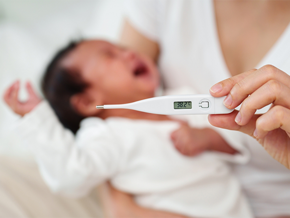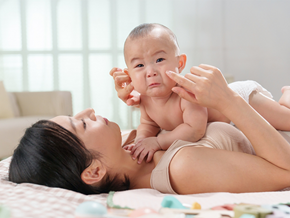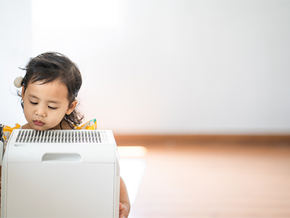
You’re changing your baby’s diaper when you see the red, irritated skin. This is the classic sign of a diaper rash. Although it may look uncomfortable, the good news is that you can usually treat it quickly at home. Continue reading to learn how to soothe your little one’s skin and prevent the rash from recurring.
What Is Diaper Rash?
According to the American Academy of Pediatrics (AAP), diaper rash is a common and often stubborn skin irritation that peaks in babies between 9 and 12 months old.
You'll usually notice mild pink or red patches in the diaper area. More serious cases can appear bright red and scaly, or even develop tiny blisters or sores. Your baby may also be extra fussy during diaper changes.
If you see these signs, don't panic. Identifying the cause is the first step toward finding proper treatment.
Diaper Rash: Types and Treatments
To pinpoint the cause, take a look at the most common diaper rash types.
Irritant diaper rash
This skin irritation stems from prolonged contact with urine and stool, explains the AAP. You’ll usually see it as pink or red patches, but the skin inside the groin folds often looks clear because it's more protected.
Keep the area clean and dry. During every diaper change, apply a diaper rash cream with zinc oxide. For a severe rash, the American Academy of Dermatology Association advises applying it thickly, like you're frosting a cake. Frequent changes and diaper-free "air time" also help the skin heal.
Yeast diaper rash
A yeast diaper rash happens when Candida—a fungus naturally present in the body—overgrows due to lingering moisture trapped in the diaper area. This moist, humid environment is the perfect breeding ground for yeast.
The rash appears puffy and bright red with sharp edges, typically inside the skin folds. Look for small red bumps or pimples (called "satellite spots") spreading out from the main rash.
This type of rash requires a call to your pediatrician.
Allergic reaction rash

Sometimes, your baby's sensitive skin may have an allergic reaction to an ingredient in a product, such as a diaper, wipe, or cream. You'll often see a bright red rash, sometimes with bumps. You’ll know it’s an allergy rash because of the sharp, clear borders that outline where the product touched your baby's skin.
If you suspect an allergy, you need to see your pediatrician. They can confirm the diagnosis and recommend the right treatment for the severe irritation. The diaper rash treatment for an allergic reaction typically involves identifying and removing the trigger. As the rash heals, you can continue to soothe the skin with a simple barrier cream.
Bacterial infection rash
While rare, a bacterial infection can sometimes cause a diaper rash or make an existing one worse. Watch for key signs: bright red skin just around the anus may signal a Strep infection, while yellow crusting or pimples can be a sign of Staph. If you notice any of these symptoms, consult your pediatrician for treatment.
Home Remedies for Diaper Rash
Looking for natural rash treatments? It's always best to consult your pediatrician before trying any at-home treatments, as the right remedy depends on the specific type of rash your baby has.
You can ask them about gentle options like colloidal oatmeal baths, virgin coconut oil, or even applying breast milk. According to Dr. Riza Milante, FDSP-PDS, DDSP-PDS, ICDP-UEMS, of Daily Skin Clinic, "These are for mild irritation. Stronger irritation [means] there might already be an overlying infection. If that's the case, you might need medication."
For moderate to severe rashes, Dr. Milante advises going to a board-certified dermatologist and having it checked.
If your doctor gives the go-ahead for at-home care, then consider these popular options for mild irritant diaper rash.
Colloidal oatmeal baths
Dr. Milante confirms that a colloidal oatmeal bath "works very, very well. It can soothe irritation."
This highly effective, science-backed remedy can help heal irritant diaper rash. A 2025 study in the Journal of Neonatal Nursing found that applying colloidal oatmeal was so effective that it completely resolved diaper rash in preterm babies within four days.
Colloidal oatmeal features natural compounds proven to reduce inflammation and soothe irritation. Adding a few tablespoons of it to a lukewarm bath is a safe way to help your baby's skin heal quickly.
Virgin coconut oil
A 2006 local randomized controlled trial published in Herdin found that babies treated with VCO healed faster, with a higher cure rate after seven days of use. Dr. Milante explains that virgin coconut oil can be effective because it's moisturizing and has anti-inflammatory properties.
However, she advises caution. "The problem with oil in the Philippines is that it's a tropical country, so sometimes, if it gets too kulob, you can cause a candidal (yeast) infection. So, you have to keep that in mind."
Topical breast milk
Clinical research found that breast milk’s natural antibacterial and anti-inflammatory properties may help heal diaper rash. A 2017 study in Dermatology Reports found that applying breast milk may help heal rashes faster than standard care.
To try it at home, Dr. Milante suggests using leftover milk that your baby is not going to drink anymore.
"For example, you made your baby drink breast milk. Usually may tira-tirang konti. You can't give it again to the baby because the baby is full and it’s only good for how many hours. Then, you can use that to help [with] diaper rash."
Apply a few drops to clean, dry skin and let it air-dry completely before putting on a new diaper. While this breast milk may be effective for mild irritation, this remedy may not be substitute for medical treatment for a severe or persistent rash.
How to Prevent Diaper Rash

The key to protecting your baby's skin is prevention. Follow these steps before a rash starts.
- Keep your baby’s skin clean. Change diapers as soon as they're wet or soiled and always pat the skin completely dry.
- Make sure the diaper fits snugly, without rubbing or chafing. A checklist of baby essentials typically includes different diaper sizes.
- Consider cloth diapers to reduce irritation. Dr. Milante notes, "Sometimes the rash is due to exposure to certain chemicals found in diapers to keep it dry."
- Use a barrier cream preventatively. Apply a thin layer of zinc oxide cream at each change to protect the skin from moisture.
- Choose gentle, fragrance-free products. Opt for hypoallergenic wipes, soaps, and laundry detergents to minimize irritation.
When to Call the Doctor
Most diaper rashes clear within a few days of home care, but contact your pediatrician if you notice any of the following:
- The rash doesn't improve after three days of home treatment.
- The skin is cracked, bleeding, or has pus-filled sores.
- Your baby develops a fever.
- The rash is bright red with spots spreading from the main area (a sign of a yeast infection).
- Your baby seems to be in significant pain.
Dr. Milante adds that you should also see a doctor for a persistent rash to rule out other, rarer conditions. "There are other medical causes of diaper rash," she explains, such as Langerhans cell histiocytosis or a genetic zinc deficiency called Acrodermatitis enteropathica, which can mimic a diaper rash.
Dealing with a diaper rash is common when caring for your little one, and it’s easy to treat once you know its cause. Remember, keeping your baby’s skin clean, dry, and protected will help them stay comfortable and happy.
Connect with other parents on the ParentTeam Moms and Dads Facebook group and share your own tips on how to treat diaper rash!
REFERENCES
R. Milante, Personal Communication, October 15, 2025
Benitez Ojeda, A. B., and M. D. Mendez. "Diaper Dermatitis." In StatPearls. StatPearls Publishing, last updated July 3, 2023. Accessed October 6, 2025. https://www.ncbi.nlm.nih.gov/books/NBK559067/.
Cleveland Clinic. "Diaper Rash (Diaper Dermatitis)." Cleveland Clinic, n.d. Accessed October 6, 2025. https://my.clevelandclinic.org/health/diseases/11037-diaper-rash-diaper-dermatitis.
Farahani, L. A., M. Ghobadzadeh, and P. Yousefi. 2013. "Comparison of the Effect of Human Milk and Topical Hydrocortisone 1% on Diaper Dermatitis." Pediatric Dermatology 30, no. 6 (November-December): 725–9. Accessed October 6, 2025. https://doi.org/10.1111/pde.12118.
Harisa, Irna, and Mizwar Taufiq Pirmansyah. 2023. “The Effect of Virgin Coconut Oil (VCO) Application on Diaper Rashes in Infants at the UPTD Puskesmas Sindang Jaya, Tangerang District 2023.” Journal for Quality in Women’s Health 6 (2): 89–94. Accessed October 6, 2025. https://doi.org/10.30994/jqwh.v6i2.218.
Mayo Clinic Staff. "Diaper rash." Mayo Clinic, n.d. Accessed October 6, 2025. https://www.mayoclinic.org/diseases-conditions/diaper-rash/symptoms-causes/syc-20371636.
Medically reviewed by Michelle P. Tellado, MD. "Diaper Rash." Nemours KidsHealth, September 2023. Accessed October 6, 2025. https://kidshealth.org/en/parents/diaper-rash.html.




























